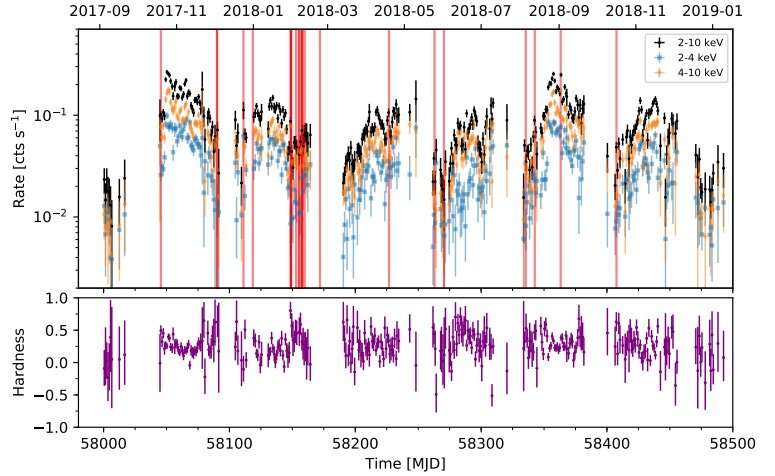August 21, 2019 report
MAXI J1621–501 is a low-mass X-ray binary, study finds

An international team of astronomers has uncovered important insights about the recently discovered transient source known as MAXI J1621–501. Results of new observations conducted with NASA's NuSTAR spacecraft indicate that the object is a low-mass X-ray binary. The finding is detailed in a paper published August 9 on arXiv.org.
X-ray binaries consist of a normal star or a white dwarf transferring mass onto a compact a neutron star or a black hole. Based on the mass of the companion star, astronomers divide them into low-mass X-ray binaries (LMXB) and high-mass X-ray binaries (HMXB).
Some LMXBs exhibit transient outbursts, during which an increase in X-ray luminosities is observed. When these outbursts are characterized as Type I X-ray bursts—thermonuclear explosions taking place on the surface layers of neutron stars—they obviously confirm the presence of neutron stars in such binaries.
MAXI J1621–501 (J1621 for short) is one of the sources in which Type I X-ray bursts were identified. The transient was first detected by the Monitor of All-sky X-ray Image (MAXI) Nova Alert System on October 19, 2017.
Two months later, a follow-up observational campaign of this transient commenced using the Nuclear Spectroscopic Telescope Array (NuSTAR), resulting in the detection of two Type I X-ray bursts. Further monitoring of J1621 with ESA's INTEGRAL satellite, MAXI and the Neutron Star Interior Composition Explorer (NICER) revealed 22 more bursts of this type. All in all, these observations allowed a group of astronomers led by Nicholas M. Gorgone of the George Washington University, Washington, D.C., to confirm that J1621 is an LMXB hosting a neutron star.
.
"Further observations with NuSTAR revealed two Type I X-ray bursts, identifying MAXI J1621-501 as a low-mass X-ray binary with a neutron star primary," the astronomers wrote in the paper.
The results indicate that the accretor in J1621 is a neutron star with an estimated mass of around 1.4 solar masses. The mass of the companion star is assumed to be between 0.3 and 1.0 solar masses. The system's orbital period was calculated to be within the range from three to 20 hours, while its X-ray luminosity is most likely between 0.45 and 5.98 undecillion erg/second. The binary is estimated to be located not farther away than 16,300 light years.
According to the study, the most intriguing thing about J1621 is the episodic nature of the observed outbursts as 78-day variations in its X-ray light curve have been identified. The astronomers assume that this could be due to the so-called "super-orbital periods" or long periods.
"A better name for them would be 'long time-scale modulations', since very often they are not strictly periodic; individual modulations in the J1621 light curve vary from approximately 50 to 90 days in duration. (…) We see that for reasonable values of the system parameters, the 82 day radiative precession period we predict is close to the observed long time-scale modulation of 78 days," the researchers explained.
Summing up the results, the authors of the paper noted that J1621 is an important addition to a relatively short list of sources characterized with super-orbital periods. It is also the 111th Type I X-ray burster identified to date.
More information: Discovery and Identification of MAXI J1621-501 as a Type I X-ray Burster with a Super-Orbital Period, arXiv:1908.03590 [astro-ph.HE] arxiv.org/abs/1908.03590
© 2019 Science X Network




















